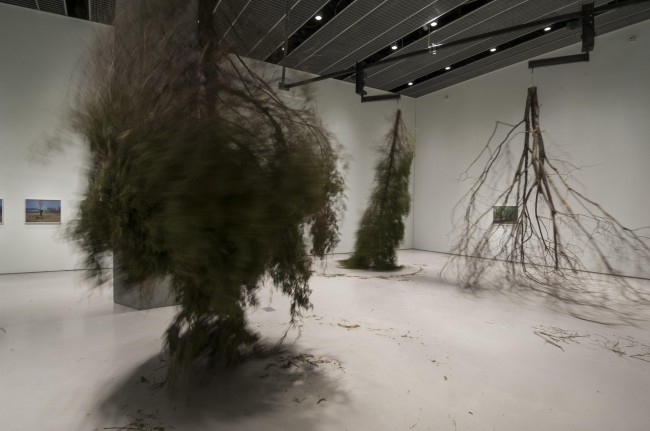A dip into the waters of sculptural history reveals a spectrum of works ranging from the equestrian statue of Marcus Aurelius (erected somewhere between 176 and 180 AD) to Dieter Roth’s 1972 biodegradable rabbit (excreted probably that same year). What defines sculpture as sculpture is ever evolving, and right there, swaying between dry land and the middle of the sea, we find Michael Sailstorfer’s work.
Read any synopsis written on Sailstorfer’s work and you will find fairly similar claims about his sculptural pioneering and uncanny matchmaking. But at the heart of his whimsical contraptions and curious constructions is a conceptual artist who is not so much breeching the constraints of sculptural limitations as he is questioning the viewer’s perception of reality (which he does quite brilliantly). By way of kinetic trees, stagnant clouds, and manufactured shooting stars, we are presented with ideas of time, relationships, and impact as they pertain to our understanding of the world. He plays off of the shift in our moral code, one that has digressed from deep-rooted philosophical environmentalism to eco-conscience trendiness. He toys with our cognizance, trumping popular cultural belief about material. He sets it all within a framework of fascination and romanticism to undermine our idealism.

Anti-Herbst (“Anti-Autumn”), 2012-13, video [9:15], Courtesy of the Contemporary Art Center, copyright Tony Walsh
Our relationship with the environment is directly correlated to our understanding of material. What we perceive as “industrial” is bad and what is “green” is good when really they are one in the same. It is the former philosophy that establishes cultural norms (norms such as what you buy, what you eat, how you travel, and where you live) that are perpetuated by misconception. This is showcased exquisitely among the tress of Forst.

Forst (“Forest”), 2010, Trees, Engines, Steel Construction, Courtesy of the Contemporary Art Center, copyright Tony Walsh
Transposing woody plants and alloy apparatuses, Sailstorfer creates a simulation of the senses, visually, audibly, and spatially. He heightens our attraction to the material by creating an experiential relationship between us and the physical composition of the sculpture. While our reaction is emotional, what is brought into question is our intellectual capacity to connect with the material. The reality is both the trees and the steel construction are extractions from the earth, and that with time, will degrade, deteriorate, and break down entirely. So the message is not one of manufactured vs. natural, industry vs. environment – it is one of synonymy. He accomplishes this through witty references to classical sculpture. Though oriented upside, Forst is both figurative (the trees) and commemorative (the steel base.) The experience is truly fascinating in all senses of the word.
An early exploration of the artist is quietly fixed beneath the shadow of the clouds (see: Wolken, 2010). Reversing Andy Goldsworthy’s concepts, Sailstorfer turns the plot of land into his sculpture through the processes of deduction rather than addition.
Waldputz is an interrupted landscape, sterile in aesthetic and production, desolate and stark. The once fertile ground has been stripped of its vegetation and the trees deprived of their bark. Having removed the organisms methodically, Sailstorfer presents us with damage that is quantifiable. This patch of land, this sterile garden, is the materialization of our relational detachment from ourselves and the impact that we have.
As in Forst, and Anti-Herbst too, Waldputz speaks to our understanding of material – how we qualify it – resulting in how we relate to it. The feeling of detachment, or human apathy, that Sailstorfer conveys in his work is partly due to our own lack of (in)sight. Looking at the life of a material comprehensively (i.e. the energy used to grow it, extract it, transport it, use it, degrade it, and everything before, after, and in between) may help us better relate to the world around us.
If Jonas Salk were to describe the work, or perhaps the show as a whole, he would put it this way: “If all the insects were to disappear from the earth, within 50 years all life on earth would end. If all human beings disappeared from the earth, within 50 years all forms of life would flourish.”
See the trees for yourself at the Contemporary Arts Center.
On display through September 14.
By: Hannah Leow




